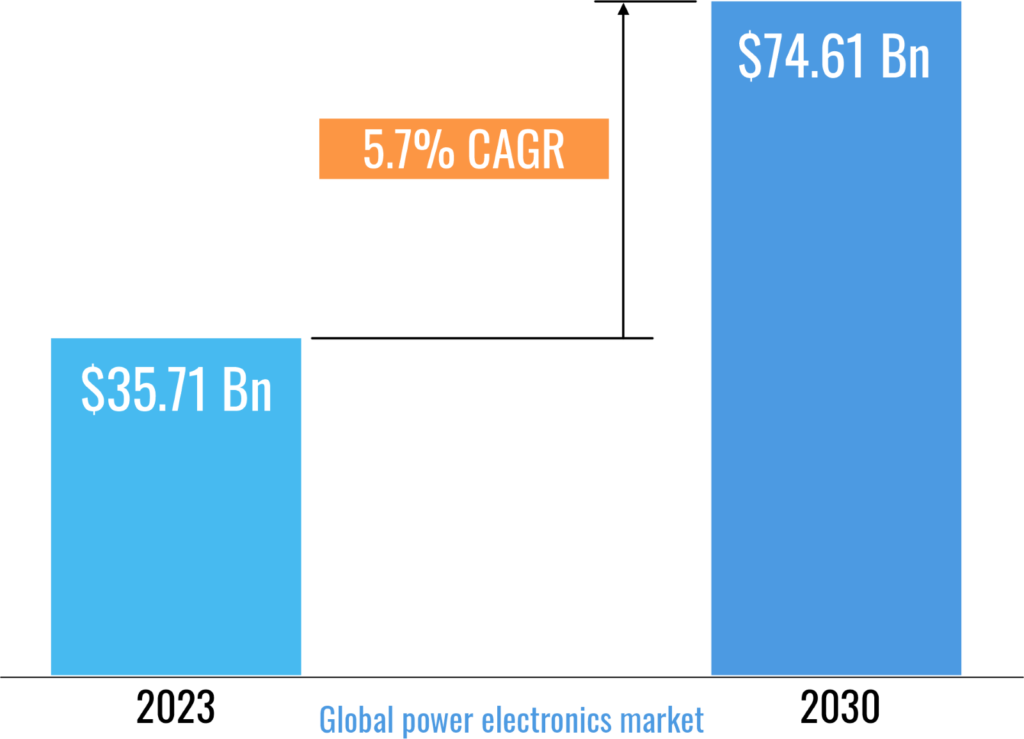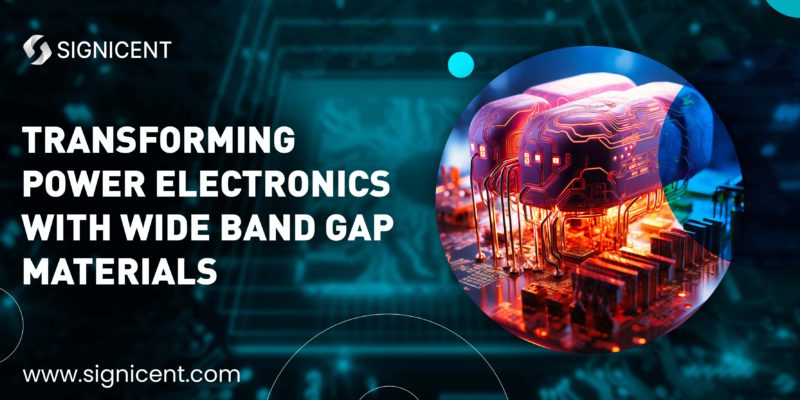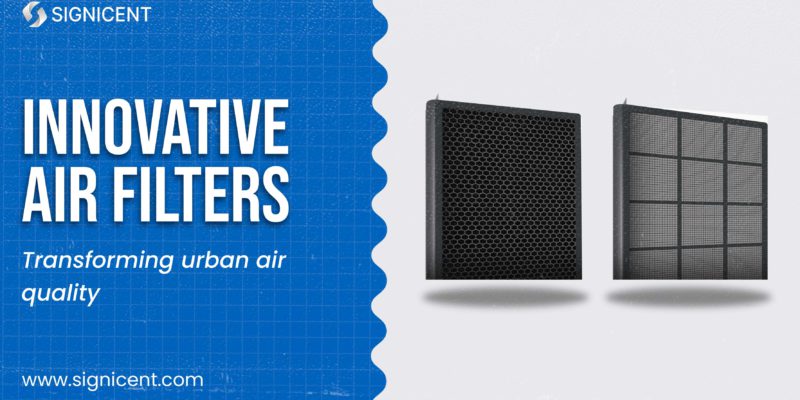Introduction:
In the rapidly evolving field of power electronics, innovation is the key to enhancing efficiency and performance. Traditional silicon-based semiconductors are reaching their limits, paving the way for a new era defined by Wide Band Gap (WBG) materials. Among these, Silicon Carbide (SiC) and Gallium Nitride (GaN) are at the forefront, promising to revolutionize how we manage and convert electrical power. These advanced materials offer superior electrical properties, including higher efficiency, faster switching speeds, and greater thermal stability. As industries demand more robust and efficient Technology Scouting solutions, SiC and GaN are becoming essential in applications ranging from electric vehicles to renewable energy systems, setting new standards in power electronics.
Why SiC and GaN Are the Future of power electronics?
As the demand for more efficient and reliable power systems grows, Silicon Carbide (SiC) and Gallium Nitride (GaN) are emerging as the materials of choice in power electronics. Their superior electrical properties enable higher efficiency and faster switching speeds, which are crucial for modern applications.
SiC is particularly valuable in electric vehicles and renewable energy systems, where efficiency and thermal stability are paramount.
GaN, with its high electron mobility, is ideal for high-frequency applications, including telecommunications and data centers.
These Wide Band Gap materials are driving the future of power electronics, offering solutions that outperform traditional silicon and support the growing needs of advanced technologies.
Major Challenges in Power Electronics:
In power electronics, metals like copper, aluminum, gold, silver, nickel, tin, and lead are used alongside semiconductors like silicon, SiC, and GaN. They serve various functions such as conductivity, thermal dissipation, and interconnections.
Why Move Away from Traditional Silicon?
Ever wondered why the industry is shifting from traditional silicon to new materials like SiC and GaN? Silicon has been the backbone of power electronics for decades, but it’s reaching its physical limits.
Here are some of the drawbacks of silicon that SiC and GaN overcome:
- Lower Efficiency: Silicon devices have higher energy losses during power conversion, leading to less efficient systems.
- Slower Switching Speeds: Silicon transistors can’t switch as quickly as those made from SiC or GaN, limiting their performance in high-frequency applications.
- Thermal Limitations: Silicon components struggle to operate at high temperatures, requiring extensive cooling systems which add to the size and cost of electronic devices.
- Voltage Handling: Silicon devices are less capable of handling high voltages without significant losses or the risk of breakdown, restricting their use in high-power applications.
Real-Life Advantages in power electronics by using SiC and GaN :
The power electronics industry has long relied on silicon, but this dependency comes with significant challenges that are evident in various real-life applications:
Efficiency Boost:
- Electric Vehicles (EVs): Silicon-based power electronics in EVs often lead to higher energy losses during power conversion, reducing overall efficiency. This means shorter driving ranges and more frequent charging.
Solution with SiC: Using SiC in EV powertrains can significantly increase efficiency, extending the driving range and reducing the frequency of charges, making EVs more practical for daily use.
Better Thermal Management:
- Data Centers: Silicon components in data centers generate excessive heat, requiring large and costly cooling systems to maintain optimal performance. This increases operational costs and energy consumption.
Solution with GaN: GaN components can operate at higher temperatures with better thermal management, reducing the need for extensive cooling infrastructure, lowering operational costs, and improving energy efficiency.
Faster Switching Speed:
- Telecommunications: In high-frequency applications like 5G networks, silicon transistors switch slower, leading to inefficiencies and performance bottlenecks.
Solution with GaN: GaN transistors offer ultra-fast switching speeds, enhancing the performance and reliability of 5G infrastructure and other high-frequency applications, ensuring faster data transmission and lower latency.
Voltage Handling Capabilities:
- Renewable Energy Systems: Silicon devices struggle to handle high voltages efficiently in solar inverters, leading to energy losses and less efficient power conversion.
Solution with SiC: SiC-based solar inverters can handle higher voltages more efficiently, improving the overall energy yield from solar panels and making renewable energy systems more viable and cost-effective.
Compactness of devices:
- Consumer Electronics: The physical constraints of silicon limit advancements in consumer electronics, resulting in devices that are bulkier and less efficient.
Solution with GaN: GaN allows for smaller, more efficient power adapters and chargers, leading to sleeker, more powerful consumer electronics that offer better performance and convenience.
Signicent’s proactive involvement inTechnology gap analysisis illustrated by its continual research and development initiatives.
Each year Signicent provides consultancy to hundreds of organizations to help transform their innovations to value.
Applications:
WBG semiconductor electronic components are great for power applications, but they are widely used in a variety of industries:
Furthermore, SiC and GaN are very good in producing extremely efficient and compact devices.
- The electric mobility sector, including electric cars and charging infrastructures, benefits from WBG components capable of delivering high power outputs.
- Clean energy production sectors like wind and solar utilize SiC and GaN components for systems operating at megawatt levels.
- The railway transport sector employs WBG components for managing powerful engines, while industrial automation relies on them for controlling robotic devices and automatic machines.
- WBG components are widely used in energy converters, driving electric motors, inverters, LED lighting systems, power supplies, and communication devices.
- SiC, with its ability to withstand high voltages and increased thermal conductivity, is ideal for high-power applications such as electricity transmission systems, electric vehicles, photovoltaic systems, and charging stations.
- SiC converters enhance the efficiency of electricity conversion in solar and wind energy systems, increasing energy production from renewable sources.
- Higher switching frequencies of WBG devices enable the creation of faster, more precise, and compact devices, reducing the size and cost of inductive components like inductances and transformers.
Market Research:
According to Signicent’s Market Intelligence, the global market for power electronics is likely to reach values in the ranges shown below.

Key players:
some key players in the field of Wide Band Gap (WBG) semiconductor technology, known for their contributions to future projects:
Wolf Speed – US
Infineon – Germany
Toshiba – Japan
STMicroelectronics – Switzerland
NXP Semiconductors – Netherlands
Mitsubishi Electric – Japan
ROHM Semiconductor – Japan
In the ever-changing technology landscape of wide band gap (WBG) semiconductor technology, innovation propels us forward. We are accelerating developments in power electronics with the help of world leaders, including our major contributions. Together, we are creating a future in which efficiency and dependability redefine technological potential.
Services Offered:
- Technology Intelligence
- Market Research
- Patent Landscape
- Technology gap analysis
- Design Patent Search
- Portfolio Analysis
- Freedom to operate
- Bio Sequence Search
- Innovation pipeline identification
- Chemical Structure Search
- Patent Invalidity Search
- Manufacturers Search/ Supplier search
- Patent Licensing Services
Elevate your Innovation and Research with Signicent’s cutting edge approach to assist you with Technology and Market related matters alongside the IP aspect of the analysis.


